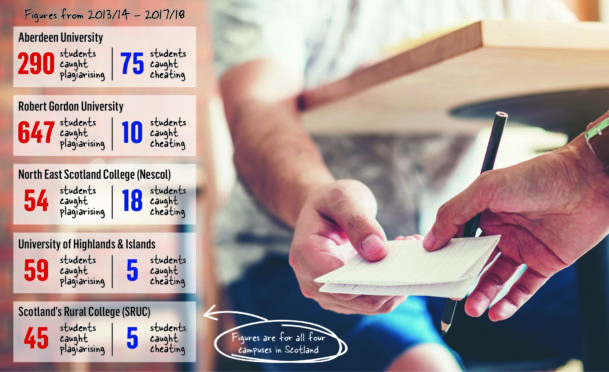Thousands of students have been caught cheating or plagiarising in the past five years.
Figures obtained through Freedom of Information reveal that 1,144 people have been caught cheating in exams, or using others’ work for essays and assignments since the academic year of 2013/14.
Aberdeen University has confirmed that 290 people were caught plagiarising in the past five years, while a further 75 were found to be cheating during exams.
The Robert Gordon University reported that 647 students breached copying rules and 10 were caught cheating.
Meanwhile the Highlands and Islands University reported there had been 59 plagiarisers and five exam cheats during the same period.
>> Keep up to date with the latest news with The P&J newsletter
North East Scotland College (Nescol) revealed there had been 54 plagiarists and 18 students caught cheating.
Scotland’s Rural College (SRUC) – which has four campuses, including one at Craibstone – said there had been 45 students caught plagiarising and five found to be cheating in that time.
All five institutions use Turnitin, a software programme where students submit work, which detects whether they have failed to put other sources into their own words or reference its use.
And they say that most cases of plagiarism are due to poor referencing rather than deliberate cheating.
Last night, all three universities insisted they take a hardline on students who are caught cheating in exams.
A RGU spokesman said: “We have processes in place to detect misconduct. Exams are robustly invigilated using an experienced team of trained external invigilators.
“A senior invigilator is assigned to every exam, along with supporting invigilators who are briefed on how to look for and manage instances of suspected misconduct.”
A spokeswoman for Aberdeen University said: “While the overwhelming majority of our students act honestly, those who do not risk their personal integrity, future career prospects or the possibility of not being awarded their degree by cheating.”
Iain Morrison, dean of students at the Highlands and Islands, said: “In the event of transgressions, students are subsequently treated firmly, but fairly. However, it must be stressed again that the vast majority of our students approach their coursework and examinations correctly and do not cheat.”
Nescol said cheating was a “very unusual occurrence” at the college and a range of policies and procedures were in place to deal with it.
